More than four fifths of Europeans used the internet in 2016
This article is outdated and has been archived on 28/05/2018 - for recent information on this topic see all articles on Digital economy and society .
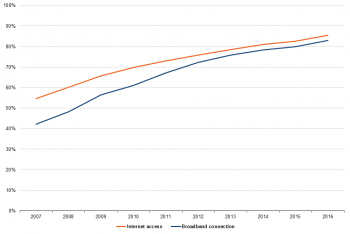
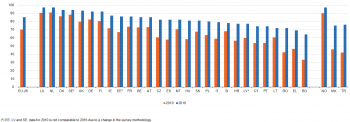

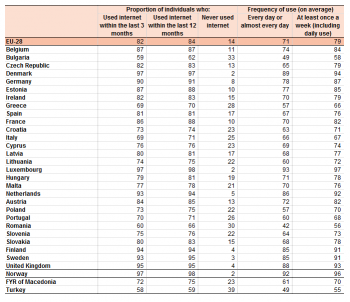
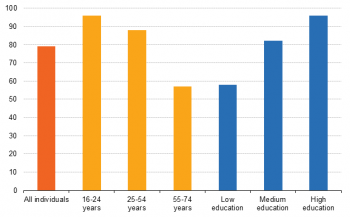
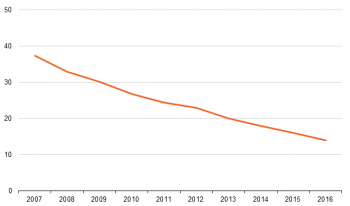

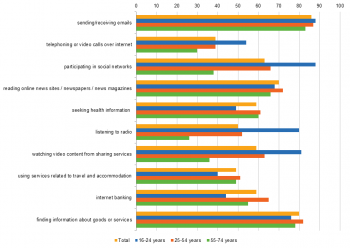
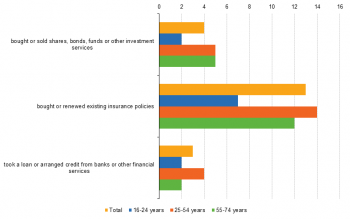
This article presents an overview of the findings of the 2016 ‘Survey on ICT (information and communication technology) usage in households and by individuals’. It takes a closer look at the type of internet connection used by households, as well as at internet users’ activities.
Main statistical findings
A large majority of Europeans used the internet in 2016. It has become important for daily life, education, work and participation in society as it enables people to access information and services at any time from any place. However, internet habits of different countries and age groups vary significantly and 14 % of the EU population have never used the internet.
High shares of households' broadband connections were recorded in the EU in 2016 with significant differences across Member States.
Internet access
In 2016, 85 % of European households had access to the internet from home. This share has been gradually increasing since 2007, when only 55 % of households had access to the internet (Figure 1).
Broadband connection is the most common technology for accessing the internet in the EU: in 2016, 83 % of the households (97 % of the households with internet access) had a fixed and/or mobile broadband connection. Over the last ten years, the percentage of households connecting to the internet with broadband almost doubled. Furthermore, in 2016 it increased by an additional two percentage points compared with 2015.
At EU-Member State level, the largest shares of households with access to the internet in 2016 (Figure 2) were registered in Luxembourg and the Netherlands (97 % each). Five other Member States presented shares of connected households above 90 %: Denmark and Sweden (94 % each), the United Kingdom (93 %), Germany and Finland (92% each). At the other end of the ranking scale, the lowest proportions were registered in Bulgaria (64 %) and Greece (69 %) followed by Romania and Lithuania (72 % each).
Between 2010 and 2016, significant increases (about 30 percentage points) in the share of households connected to the internet were observed in Bulgaria and Romania, though still remaining at the lower end of the scale. Spain, Greece, Hungary, the Czech Republic and Croatia also registered large increases (more than 20 percentage points) in the same period.
Figure 3 shows the share of households with broadband access by country. Luxembourg is the country which also displayed the highest proportion of households with broadband connection (97 %). Shares higher than 90 % were registered for the Netherlands (95 %), Denmark and the United Kingdom (92 % each) and Finland (91 %). Lowest broadband connectivity rates were again registered for Bulgaria (63 %), Greece (68 %), Romania (70 %) and Lithuania (71 %).
Internet use by individuals
More than four fifths of people (82%) in the EU used the internet at least once in the three months prior to the survey in 2016. Almost eight out of ten (79 %) used it regularly (on average at least once a week) at home, at work or elsewhere (Table 1). Although the Digital Agenda target of 75 % of the EU population using the internet by 2015 had been achieved in 2014, the level of use is still below this target for ten Member States.
In the EU, 71 % of all individuals used the internet every day or almost every day. The share of daily users was the highest in Luxembourg (93 %), followed by Denmark (89 %), the United Kingdom (88 %), the Netherlands (86 %), Sweden and Finland (85 % each). Shares lower than 60 % occurred in Greece and Poland (57 % each), Bulgaria (49 %) and Romania (42 %).
Age and level of formal education have a significant impact on the use of internet by individuals (Figure 4): differences revealed the existance of 'digital divide' across generations and educational attainment. 96 % of individuals aged 16-24 were regular internet users against 57 % in the 55-74 age group. Individuals with a higher level of education were almost all regular internet users (96 %), while less than 60 % of individuals with a lower level of education used the internet regularly.
In the EU, the proportion of individuals who have never used the internet almost halved from 37 % in 2007 to 20 % in 2013 (Figure 5). This trend has, however, slowed down in recent years: starting in 2013, the share fell by two percentage points each year to reach 14 % in 2016 (one percentage point below the Digital Agenda target fixed for 2015).
Large 'digital divides' remain as regards the level of non-use by country (Figure 6 and Table 1). The highest proportion of the population with no experience of internet use (whether at home, at work or elsewhere) was registered in Bulgaria (33 %) followed by Romania (30 %), and the lowest in Luxembourg and Denmark (2 % each). In eleven Member States (Bulgaria, Romania, Greece, Portugal, Italy, Croatia, Cyprus, Poland, Slovenia, Lithuania and Malta), more than one fifth of the population were non-internet users.
Internet activity by age group
Communication by e-mail and finding information about goods and services are the most popular activities carried out in internet. These activities are more or less equally important for internet users in all age groups (Figure 7). On average, 86 % of European internet users aged 16-74 have sent and received e-mails for private purposes and 80 % have searched for information.
Similar patterns occurred for reading online news, newspapers or magazines: 70 % of European internet users read online without significant differences among the age groups.
However, larger differences between young and older people are observed when it comes to other communication activities covered by the survey, such as social networking, and telephoning or making video calls over the internet. The share of internet users who participated in social networking was 88 % for 16-24 year olds compared to 38 % for 55-74 year olds. Similarly, 54 % of users in the age group 16-24 were making telephone and video calls through internet-based applications compared to 30 % for the age group 55-74.
Similar patterns are observed for leisure activities such as watching video content from sharing services (e.g. You Tube), as well as listening to music including web radio, music streaming, activities carried out by around 80 % of the young internet users aged 16-24. These activities are also popular for internet users aged 25-54 (63 % and 52 % respectively).
Online services related to travel or travel related accommodation are more popular among the internet users of the second and third age group (around 50 % compared to 40 % of the younger age group). Similar behaviour can be observed whilst searching out health related information. The internet is also equally considered as an important source of information and knowledge by the internet users in the second and third age group (around 60 %) in comparison to around 50 % of the youngest generation.
On average 59 % of European internet users are using online services of internet banking. This activity is second less popular among the youngest ones. Only 44 % of younger internet users performed some kind of electronic transactions with a bank (for payment, transfers, etc. or for looking up account information) against 55 % aged 55-74 and 65 % aged 25-54.
Financial activities
In 2016, slightly more than 15 % of internet users have carried out financial activities online, mostly in the 25-54 years age range (Figure 8).
The most common activity is buying or renewing insurance policy online: the most active were the internet users aged 25-54 years (14 %) followed by those aged 55-74 (12 %). Younger generations are in general not participating in financial activities. In 2016 less than 10 % of younger internet users carried out any financial activities on the internet, 7 % of them only buying or renewing their insurance policy online.
Buying or selling shares, bonds, funds or any other investment services was carried out by 5 % of the internet users in the two older age groups (25-74 years old). Only a very small share (3 %) of European internet users performed acquisitions or negotiations of loans and credit activities over the internet in 2016.
Data sources and availability
The data in this article are based on the results of annual surveys on ICT usage in households and by individuals. Data for 2016 were aggregated from micro data transmitted by all Member States and some non EU countries (Norway, the former Yugoslav Republic of Macedonia and Turkey). They are available on the Eurostat website (see link below). Researchers can apply for access to the micro data.
The 2016 survey results are based on responses from a total of 156 152 households containing at least one person aged 16-74, and 203 798 individuals aged 16-74 across the EU. Individuals were asked about the last time they used the internet, how often they used it, on which devices, use away from home or usual place of work, activities relating to e-government and e-commerce, e-skills and privacy and protection of personal identity.
In general, internet activities were carried out in the previous three months before the interview. The main reference period was the first quarter of 2016, as in most countries the data were collected in the second quarter. A 12-month reference period was used for financial activities.
The 'digital divide' refers to divergence in patterns of internet use across countries and between groups of individuals.
Levels of education are defined according to ISCED-2011 as follows: high (tertiary, ISCED 5, 6, 7 or 8); medium (upper secondary and post-secondary non-tertiary, ISCED 3 or 4); low (at most lower secondary, ISCED 0, 1 or 2).
Context
The findings of this survey are used for monitoring several EU policies, in particular the Digital Agenda for Europe, which is one of the pillars of the Europe 2020 strategy (which sets objectives for the growth of the European Union by 2020). The Digital Agenda proposes to better exploit the potential of Information and Communication Technologies (ICTs) in order to foster innovation, economic growth and progress. One of its main objectives is the completion of the Digital Single Market, in which the free movement of persons, services and capital is ensured and where individuals and businesses can seamlessly access and exercise online activities under conditions of fair competition, and a high level of consumer and personal data protection, irrespective of their nationality or place of residence. The completion of the Digital Single Market is currently one of the political priorities of the European Commission. It covers three areas: promoting better online access to goods and services across Europe; designing an optimal environment for digital networks and services to develop; ensuring that the European economy and industry takes full advantage of the digital economy as a potential driver for growth.
At the end of 2015 the European Commission published a framework called Monitoring the Digital Economy and Society 2016–2021. This document describes the main policy developments and outlines the main data requirements to monitor European digital policies, information and communication technologies as well as their impact on the economy and society in the period 2016-2021. It reviews existing data sources and lists new areas and data sources to be made use of in the future.
